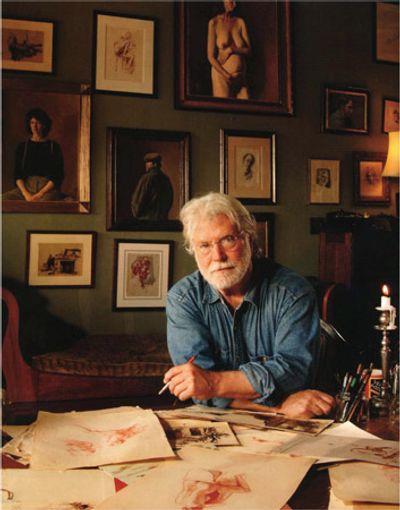Images at the Crossroads, a Ben Long Fresco
Located in the lobby of the Statesville Civic Center
From the beginning, the concept of crossroads dominated the planning sessions with artist Benjamin Long. Statesville is quite literally at the crossroads, from its proximity to two major interstates to its shifting focus. During its early years, Statesville served as a true crossroads, or common place, for pioneer travelers. Historically an agricultural center, the 21st century has seen changes in the landscape, with the addition of industry, technology and tourism. The home of the fresco, the Civic Center, is itself symbolic of the new Statesville.
Dominating the busy scene is a figure from ancient mythology, Hecate, the goddess of the crossroads. Surrounded by life, the three-faced maiden who has the power to see in all directions stands with her hand upon her chest, a sign of arrival. The fresco shows three roads converging, the ancient symbol of crossroads and its use as a common place where people come together.
Life at a crossroads is life at a point where choices are to be made – choices that involve love or hatred, justice or injustice, gossip or truth, mercy or malice, wealth or poverty, happiness or sadness, even life or death. All of these elements of life are found in the fresco and it is the artist’s desire is that you find them for yourself.
Intriguing, expertly crafted and hauntingly beautiful, Images at the Crossroads is a richly hued masterpiece. Created by international fresco artist Ben Long, this larger-than-life painting (21 feet tall by 19 feet wide) adorns a specially created wall in the Civic Center in Statesville, North Carolina.
The fresco is an ancient art form dating back to early Egyptian and Greco-Roman times. The world’s most famous fresco is the one Michelangelo painted in the Sistine Chapel during the 15 th century. Artist Ben Long has painted frescos for more than two decades in the United States and Europe.
Images at the Crossroads is an insightful, dramatic piece with a perspective that allows the viewers to feel that they are actually in the bustling scene. It portrays a crossroads from earlier times, which served as a meeting place, or common area where people came together. Watching over the active scene of people engaged in work, play, study and prayer is a mythological figure, the three-faced Hecate, the goddess of the crossroads. With the power to see in all directions, this maiden represents the choices we have as we arrive at a crossroads, whether literal or figurative.
“The images have to do with journey and choices; time and ages, conflict, contrast, the memory of things, superstition, legend, elements of an ageless history; and love, loss, labor, play and an attempt at a meaningful gathering of oppositions, all needed to weave a sense of expectation, hopefully thoughtful and interesting, with reflections of irony,” says Long.
